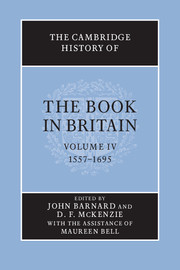Book contents
- Frontmatter
- Dedication
- Contents
- List of illustrations
- List of contributors
- Preface
- Acknowledgements
- Introduction
- RELIGION AND POLITICS
- ORAL TRADITIONS AND SCRIBAL CULTURE
- LITERATURE OF THE LEARNED
- LITERARY CANONS
- VERNACULAR TRADITIONS
- THE BUSINESS OF PRINT AND THE SPACE OF READING
- BEYOND LONDON: PRODUCTION, DISTRIBUTION, RECEPTION
- DISRUPTION AND RESTRUCTURING: THE LATE SEVENTEENTH-CENTURY BOOK TRADE
- 38 The stationers and the printing acts at the end of the seventeenth century
- STATISTICAL APPENDICES
- Abbreviations
- Bibliography
- Index
- Plate Section
- References
38 - The stationers and the printing acts at the end of the seventeenth century
from DISRUPTION AND RESTRUCTURING: THE LATE SEVENTEENTH-CENTURY BOOK TRADE
- Frontmatter
- Dedication
- Contents
- List of illustrations
- List of contributors
- Preface
- Acknowledgements
- Introduction
- RELIGION AND POLITICS
- ORAL TRADITIONS AND SCRIBAL CULTURE
- LITERATURE OF THE LEARNED
- LITERARY CANONS
- VERNACULAR TRADITIONS
- THE BUSINESS OF PRINT AND THE SPACE OF READING
- BEYOND LONDON: PRODUCTION, DISTRIBUTION, RECEPTION
- DISRUPTION AND RESTRUCTURING: THE LATE SEVENTEENTH-CENTURY BOOK TRADE
- 38 The stationers and the printing acts at the end of the seventeenth century
- STATISTICAL APPENDICES
- Abbreviations
- Bibliography
- Index
- Plate Section
- References
Summary
The Act of Parliament whose expiry on 3 May 1695 provides a convenient concluding point for this volume has been called many things. Legally speaking it was 14 Charles II, c. 33, and came into force on 10 June 1662. Its official title was ‘An Act for Preventing the frequent Abuses in Printing Seditious, Treasonable, and Unlicensed Books and Pamphlets; and for the Regulating of Printing and Printing Presses’, and contemporaries thus generally referred to it as the Printing Act. However, most subsequent scholars, following Macaulay, have called it the Licensing Act, though it has also been called the Censorship Act and, most recently, the Press Act. These labels reflect not only the varying preoccupations of those who have employed them, but also the very real variety–and confusion–of the Act itself which embodied not only the divergent general interests of its two main sponsors, but also the special interests of a number of groups or even individuals who had lobbied successfully in the Parliamentary committee to have them included.
The immediate context of the Act was the wide-ranging legislative programme undertaken during the first session of the Cavalier Parliament from 8 May 1661 to 19 May 1662, a programme which a recent historian of that Parliament has characterized as ‘the reconstruction of the old regime’. This was particularly true of the Printing Act which he correctly describes as largely ‘lifted directly out of the 1637 regulations’. Since the Star Chamber Decree of 1637 had itself been merely the last in a long line of regulatory measures from Henry VIII’s Proclamation of 1538 down through the Star Chamber Decrees of 1586 and 1637, the 1662 Act may thus be seen as the culmination of over a century of Tudor and Stuart attempts to regulate the press.
- Type
- Chapter
- Information
- The Cambridge History of the Book in Britain , pp. 755 - 776Publisher: Cambridge University PressPrint publication year: 2002
References
- 5
- Cited by



